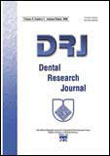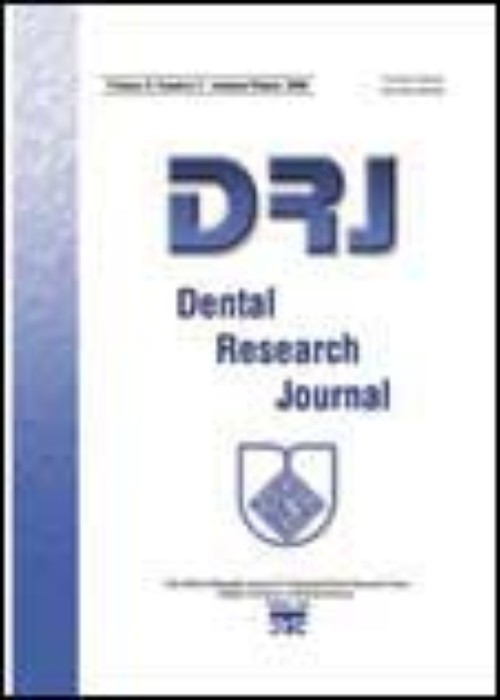فهرست مطالب

Dental Research Journal
Volume:14 Issue: 4, Jul 2017
- تاریخ انتشار: 1396/05/28
- تعداد عناوین: 11
-
-
Page 225Resin‑based composites are commonly used restorative materials in dentistry. Such tooth‑colored restorations can adhere to the dental tissues. One drawback is that the polymerization shrinkage and induced stresses during the curing procedure is an inherent property of resin composite materials that might impair their performance. This review focuses on the significant developments of laboratory tools in the measurement of polymerization shrinkage and stresses of dental resin‑based materials during polymerization. An electronic search of publications from January 1977 to July 2016 was made using ScienceDirect, PubMed, Medline, and Google Scholar databases. The search included only English‑language articles. Only studies that performed laboratory methods to evaluate the amount of the polymerization shrinkage and/or stresses of dental resin‑based materials during polymerization were selected. The results indicated that various techniques have been introduced with different mechanical/physical bases. Besides, there are factors that may contribute the differences between the various methods in measuring the amount of shrinkages and stresses of resin composites. The search for an ideal and standard apparatus for measuring shrinkage stress and volumetric polymerization shrinkage of resin‑based materials in dentistry is still required. Researchers and clinicians must be aware of differences between analytical methods to make proper interpretation and indications of each technique relevant to a clinical situation.Keywords: Analytical procedure, polymerization, resin composite, shrinkage, stress
-
Page 241BackgroundHalitosis is the presence of unpleasant or foul smelling breath. The origin of halitosis may be related to both systemic and oral conditions, but a large percentage of cases, about 90%, is generally related to an oral cause. The aim of this study was to compare the concentration of urea and uric acid in patients with halitosis and people without halitosis.Materials And MethodsIn this casecontrol study, concentration of urea and uric acid was compared between two groups: (1) persons suffering halitosis (2) control group without halitosis. Each group includes fifty patients. Unstimulated saliva was collected in both groups. Then, concentration of urea, uric acid, and creatinine was determined. The results were statistically analyzed with SPSS software version 14 (SPSS Inc., Chicago, Illinois, USA) by t‑test ( = 0.05).ResultsResults showed that salivary urea and uric acid concentration in halitosis group were significantly greater than control group (PConclusionAccording to the results, urea and uric acid concentration show increase in patient suffering halitosis, and this increase may result in oral malodor.Keywords: Halitosis, saliva, urea, uric acid
-
Page 246BackgroundThe purpose of this study was to evaluate the microbial reduction in deciduous molars using Morinda citrifolia juice (MCJ) as irrigating solution.Materials And MethodsThis was a randomized comparative study including 60 deciduous molars chosen among the patients belonging to the age group of 69 years based on the inclusion or exclusion criteria. The selected teeth were divided randomly into two groups based on irrigation solution used, that was, Group I (1% NaOCl) and Group II (MCJ). The microbial samples were collected both pre‑ and post‑irrigation and were transferred for microbial assay. Paired t‑test was used for intragroup analysis of pre‑ and post‑operative mean reduction of bacterial colony forming unit (CFU)/ml, whereas Independent t‑test was used to assess the intergroup, pre‑ and post‑operative mean reduction of bacterial CFU/ml.ResultsIn the intragroup comparison, both of the groups showed statistically significant (PConclusionBoth the irrigants, 1% NaOCl and MCJ, were significantly effective in the reduction of mean CFUs/ml postoperatively. The results of this study have confirmed the antibacterial effectiveness of MCJ in the root canals of deciduous teeth. Considering the low toxicity and antibacterial effectiveness of MCJ, it can be advocated as a root canal irrigant in endodontic treatment of primary teeth.Keywords: Deciduous, molar, plant extracts, sodium hypochlorite
-
Page 252BackgroundThe aim of this study was to evaluate and compare the changes in the mechanical properties and surface morphology of different orthodontic wires after immersion in three mouthwash solutions.Materials And MethodsIn this in vitro study, five specimens of each of 0.016 inch nickel titanium (NiTi), coated NiTi, and stainless steel orthodontic wires were selected. The specimens were immersed in 0.05% sodium fluoride (NaF), 0.2% chlorhexidine, Zataria multiflora extract, and distilled water (control) for 1.5 h at 37°C. After immersion, loading and unloading forces at 0.5 mm intervals and the elastic modulus (E) of the wires were measured using a three‑point bending test. Surface changes were observed with a scanning electron microscope (SEM). Two‑way analysis of variance and Bonferroni tests were used to compare the properties of the wires. The level of significance was set at 0.05.ResultsStatistically significant changes in loading and unloading forces and E of the orthodontic wires were observed after immersion in different mouthwash solutions (P 0.05). SEM images showed surface changes in some types ofthe orthodontic wires.ConclusionThe mouthwashes used in this study seemed to change the mechanical properties and surface quality of the orthodontic wires.Keywords: Elastic modulus, mechanical processes, mouthwashes, orthodontic wire
-
Page 260BackgroundThe aim of the study was to assess the oral health status and treatment needs and correlation between dental caries susceptibility and salivary pH, buffering capacity and total antioxidant capacity among students attending special schools of Mangalore city.Materials And MethodsIn this study 361 subjects in the age range of 1218 years were divided into normal (n = 84), physically challenged (n = 68), and mentally challenged (n = 209) groups. Their oral health status and treatment needs were recorded using the modified WHO oral health assessment proforma. Saliva was collected to estimate the salivary parameters. Statistical analysis was done using Statistical Package for Social Sciences version 17. Chicago.ResultsOn examining, the dentition status of the study subjects, the mean number of decayed teeth was 1.57 for the normal, 2.54 for the physically challenged and 4.41 for the mentally challenged study subjects. These results were highly statistically significant (PConclusionThis better dentition status of the normal compared to the physically and mentally challenged study subjects could be due to their improved quality of oral health practices. The difference in the treatment needs could be due to the higher prevalence of untreated dental caries and also due to the neglected oral health care among the mentally challenged study subjects. The salivary pH and buffering capacity were comparatively lower among the physically and mentally challenged study subjects which could contribute to their increased caries experience compared to the normal study subjects. However, further studies are needed to establish a more conclusive result on the total anti‑oxidant capacity of the saliva and dental caries.Keywords: Dental caries, education, oral health, saliva, statistics susceptibility
-
Page 267BackgroundOral cancer has one of the highest mortality rate among other malignancies. An attempt has been made to assess the genetic expression of a cell surface glycoprotein component ‑ sialic acid released by the malignant cells which will reflect on the oral squamous cell carcinoma (OSCC). The aim of this study was to estimate and correlate the salivary and serum sialic acid levels in OSCC.Materials And MethodsIn our casecontrol study, saliva and blood samples were obtained from Group 1 ‑ 10 healthy controls, Group 2 ‑ 12 well‑differentiated OSCC, Group 3 ‑ 7 moderately differentiated and 2 poorly differentiated OSCC. Serum and salivary total sialic acid levels were analyzed by Warrens thiobarbituric acid method and acidic ninhydrin method, respectively. The results were analyzed statistically by Students t‑test and Pearsons correlation coefficient (P ≤ 0.05).ResultsA significant difference in the serum and salivary sialic acid levels was observed between Group 1 and Group 3 (P = 0.01 andConclusionAs the histopathological grade progresses, there is a marked increase in level of sialic acid. There is a significant positive correlation between serum and salivary sialic acid levels in OSCC. Further research with larger sample size along with grading and staging system may highlight its significance in OSCC.Keywords: Biomarkers, carcinoma, N?acetylneuraminic acid, saliva, serum
-
Page 272BackgroundOne of the most important factors in restoration failure is microleakage at the restoration interface. Furthermore, a new generation of bonding, Scotchbond Universal (multi‑mode adhesive), has been introduced to facilitate the bonding steps. The aim of this study was to compare the microleakage of Class V cavities restored using Scotchbond Universal with Scotchbond Multi‑Purpose in two procedures.Materials And MethodsEighteen freshly extracted human molars were used in this study. Thirty‑six standardized Class V cavities were prepared on the buccal and lingual surfaces. The teeth were divided into three groups: (1) Group A: Scotchbond Universal with self‑etching procedure and nanohybrid composite Filtek Z350. (2) Group B: Scotchbond Universal with total etching procedure and Filtek Z350. (3) Group C: Scotchbond Multi‑Purpose and Filtek Z350. Microleakage at enamel and dentinal margins was evaluated after thermocycling under 5000 cycles by two methods of microleakage assay: swept source optical coherence tomography (OCT) and dye penetration. Wilcoxons signed‑rank test and KruskalWallis test were used to analyze microleakage.ResultsIn silver nitrate dye penetration method, group A exhibited the minimum microleakage at dentin margins and group C exhibited the minimum microleakage at enamel margins (PConclusionScotchbond Universal with self‑etching procedure at dentin margin exhibited more acceptable performance compared to the Scotchbond Multi‑Purpose with the two methods.Keywords: Microleakage, optical coherence tomography, universal adhesive
-
Page 282BackgroundThis study was conducted to assess the hardness of orthodontic brackets produced by metal injection molding (MIM) and conventional methods and different orthodontic wires (stainless steel, nickel‑titanium [Ni‑Ti], and beta‑titanium alloys) for better clinical results.Materials And MethodsA total of 15 specimens from each brand of orthodontic brackets and wires were examined. The brackets (Elite Opti‑Mim which is produced by MIM process and Ultratrimm which is produced by conventional brazing method) and the wires (stainless steel, Ni‑Ti, and beta‑titanium) were embedded in epoxy resin, followed by grinding, polishing, and coating. Then, X‑ray energy dispersive spectroscopy (EDS) microanalysis was applied to assess their elemental composition. The same specimen surfaces were repolished and used for Vickers microhardness assessment. Hardness was statistically analyzed with KruskalWallis test, followed by MannWhitney test at the 0.05 level of significance.ResultsThe X‑ray EDS analysis revealed different ferrous or co‑based alloys in each bracket. The maximum mean hardness values of the wires were achieved for stainless steel (SS) (529.85 Vickers hardness [VHN]) versus the minimum values for beta‑titanium (334.65 VHN). Among the brackets, Elite Opti‑Mim exhibited significantly higher VHN values (262.66 VHN) compared to Ultratrimm (206.59 VHN). VHN values of wire alloys were significantly higher than those of the brackets.ConclusionMIM orthodontic brackets exhibited hardness values much lower than those of SS orthodontic archwires and were more compatible with NiTi and beta‑titanium archwires. A wide range of microhardness values has been reported for conventional orthodontic brackets and it should be considered that the manufacturing method might be only one of the factors affecting the mechanical properties of orthodontic brackets including hardness.Keywords: Casting technique, dental, hardness, metals, orthodontic brackets, orthodontic wires
-
Page 288BackgroundThe aim of this cross‑sectional study was to evaluate the association between stress, salivary cortisol, and periodontitis among the inmates of the central prison.Materials And MethodsSeventy inmates were grouped depending on their pocket depth into Group A (pocket depth >4 mm andResultsThe CALs, the stress score and the salivary cortisol levels were significantly higher in Group B (PConclusionWithin the limits of this study, it can be concluded that there is a positive relation between stress and periodontal disease. The study suggests that salivary cortisol level can be used as a marker to assess stress.Keywords: Cortisol, periodontitis, stress
-
A unique case of clear cell variant of calcifying epithelial odontogenic tumor involving the maxillaPage 293Calcifying epithelial odontogenic tumor (CEOT) is a rare, benign, odontogenic tumor arising from the odontogenic epithelium and accounts for approximately 1% of all odontogenic tumors. Clear cell variant of CEOT is a distinct entity and has more aggressive biological behavior and higher chances of recurrence. Here, we present a unique case of clear cell variant of CEOT involving the left side of the maxillary alveolus in a 73‑year‑old female patient with thorough clinical, radiological, and histological details.Keywords: Amyloid, calcifying epithelial odontogenic tumor, Congo red, odontogenic tumor


